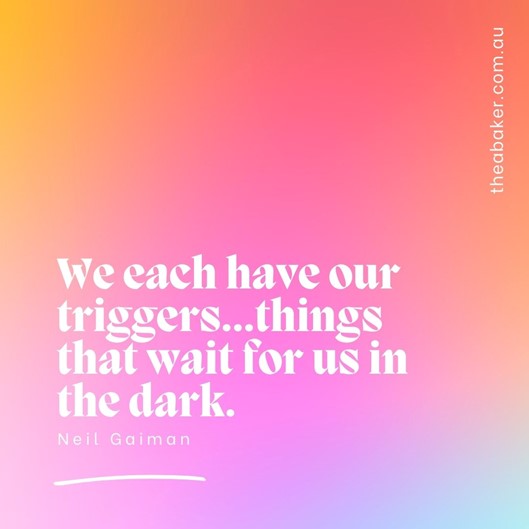Tackling Triggers
Tackling Triggers
Being ‘triggered’ is something we often hear out in the world, on socials and in TV shows. It’s quite an over-used colloquialism in these spaces. But, in a psychological sense, triggers are most often associated with traumatic events and diagnoses of PTSD and Complex-PTSD and they can be super problematic to navigate. Triggers are reminders of past traumas. This reminder can cause us to feel overwhelming sadness, anxiety or panic. Triggers can also then cause us to experience vivid pictures of memories of the traumatic event – flashbacks, making us feel that we are actually reliving the worst of those moments.
What we know about triggers:
- Firstly, triggers have NOTHING to do with being too sensitive
- Triggers can take many forms – they can be related to a physical place (like a location of where the trauma occurred), a day/date/time (such as the anniversary of a trauma), a smell or sound that takes you back to the trauma or sometimes triggers occur when internal stress escalates beyond tolerable levels.
- There are other mental health conditions where triggers are associated with recovery such as in substance abuse or eating disorders.
How triggers are formed:
- There are a few debates around this one – when we escalate to fight/flight a number of other bodily functions are taken offline while we’re busy with the primary function of staying alive. One of these functions include short-term memory formation. One belief around triggers is that our brain misfiles traumatic events in the ‘still-happening’ part of the brain, as opposed to recognising that the trauma has occurred in the past. Therefore, when we’re reminded of the traumatic event, our body reacts as if we are right there returning our body to that fight/flight mode.
- Another theory around this is that triggers are so powerful because they involve all of our senses – sights, sounds, smells and physiological responses. The more sensory information we store, the easier it is to recall. During a traumatic event, our brain ingrains sensory stimuli into our memory so when we encounter the same stimuli in another context we can be triggered. Oftentimes a sensory trigger can cause an emotional reaction before we even realise why we are upset.
- Lastly, habit is also involved – when we do the same things in the same way, our brain stores those patterns in non-linear ways that can be triggered when some part of the pattern comes up
Navigating triggers:
There are a number of different approaches that we might take at different stages of working with PTSD and C-PTSD. The first thing we need is to get curious about when or under what circumstances we are getting triggered. Our triggers are telling us something – they point to the healing that needs to happen but we need to start collecting all the different pieces of information about when / where / how it is happens for us and under what specific circumstances.
Then we might start to explore navigating body-mind approaches to regulating our fight/flight responses or triggers. This might look like relaxation, mindfulness / presence practices, meditation or grounding strategies.
Depending on how debilitating or invasive our triggers are we might choose to take steps to avoid situations or circumstances that we know might cause or exacerbate triggers.
Lastly, one of the reasons that I’m so committed to working with psychotherapeutic approaches to trauma recovery like EMDR, Compassionate Inquiry, Somatic Experiencing and Internal Family Systems is because these approaches work with the multi-sensory aspect of traumatic memories. Ultimately, we need to work through the traumatic events, processing them and the most empirically researched approaches to doing this work is in somatic psychotherapeutic approaches like these.
If you are struggling with triggers right now, we have a team of therapists at Thea Baker Wellbeing and we have IMMEDIATE availability – please reach out to us at: hello@theabaker.com.au / 03 9077 8194.


